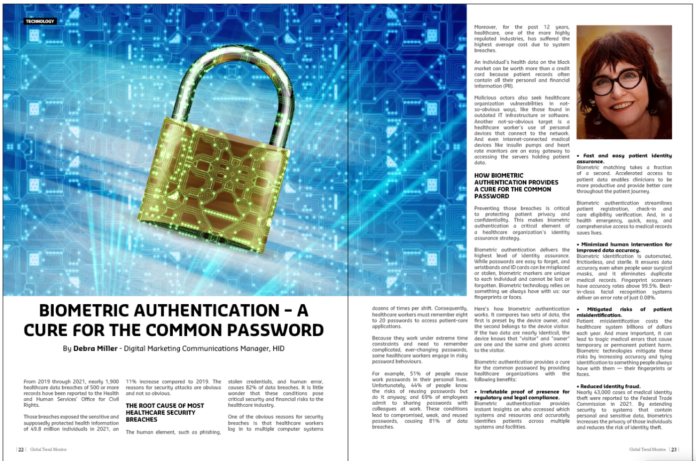By Debra Miller – Digital Marketing Communications Manager, HID
From 2019 through 2021, nearly 1,900 healthcare data breaches of 500 or more records have been reported to the Health and Human Services’ Office for Civil Rights. Those breaches exposed the sensitive and supposedly protected health information of 49.8 million individuals in 2021, an 11% increase compared to 2019. The reasons for security attacks are obvious and not so obvious.
The Root Cause of Most Healthcare Security Breaches
The human element, such as phishing, stolen credentials, and human error, causes 82% of data breaches. It is little wonder that these conditions pose critical security and financial risks to the healthcare industry.
One of the obvious reasons for security breaches is that healthcare workers log in to multiple computer systems dozens of times per shift. Consequently, healthcare workers must remember eight to 20 passwords to access patient-care applications.
Because they work under extreme time constraints and need to remember complicated, ever-changing passwords, some healthcare workers engage in risky password behaviours. For example, 51% of people reuse work passwords in their personal lives. Unfortunately, 44% of people know the risks of reusing passwords but do it anyway; and 69% of employees admit to sharing passwords with colleagues at work. These conditions lead to compromised, weak, and reused passwords, causing 81% of data breaches.
Moreover, for the past 12 years, healthcare, one of the more highly regulated industries, has suffered the highest average cost due to system breaches. An individual’s health data on the black market can be worth more than a credit card because patient records often contain all their personal and financial information (PII).
Malicious actors also seek healthcare organization vulnerabilities in not-so-obvious ways, like those found in outdated IT infrastructure or software. Another not-so-obvious target is a healthcare worker’s use of personal devices that connect to the network. And even internet-connected medical devices like insulin pumps and heart rate monitors are an easy gateway to accessing the servers holding patient data.
How Biometric Authentication Provides a Cure for the Common Password
Preventing those breaches is critical to protecting patient privacy and confidentiality. This makes biometric authentication a critical element of a healthcare organization’s identity assurance strategy.
Biometric authentication delivers the highest level of identity assurance. While passwords are easy to forget, and wristbands and ID cards can be misplaced or stolen, biometric markers are unique to each individual and cannot be lost or forgotten. Biometric technology relies on something we always have with us: our fingerprints or faces.
Here’s how biometric authentication works. It compares two sets of data, the first is preset by the device owner, and the second belongs to the device visitor. If the two data are nearly identical, the device knows that “visitor” and “owner” are one and the same and gives access to the visitor.
Biometric authentication provides a cure for the common password by providing healthcare organizations with the following benefits:
- Irrefutable proof of presence for regulatory and legal compliance. Biometric authentication provides instant insights on who accessed which systems and resources and accurately identifies patients across multiple systems and facilities.
- Fast and easy patient identity assurance. Biometric matching takes a fraction of a second. Accelerated access to patient data enables clinicians to be more productive and provide better care throughout the patient journey. Biometric authentication streamlines patient registration, check-in and care eligibility verification. And, in a health emergency, quick, easy, and comprehensive access to medical records saves lives.
- Minimized human intervention for improved data accuracy. Biometric identification is automated, frictionless, and sterile. It ensures data accuracy even when people wear surgical masks, and it eliminates duplicate medical records. Fingerprint scanners have accuracy rates above 99.5%. Best-in-class facial recognition systems deliver an error rate of just 0.08%.
- Mitigated risks of patient misidentification. Patient misidentification costs the healthcare system billions of dollars each year. And more important, it can lead to tragic medical errors that cause temporary or permanent patient harm. Biometric technologies mitigate these risks by increasing accuracy and tying identification to something people always have with them — their fingerprints or faces.
- Reduced identity fraud. Nearly 43,000 cases of medical identity theft were reported to the Federal Trade Commission in 2021. By extending security to systems that contain personal and sensitive data, biometrics increases the privacy of those individuals and reduces the risk of identity theft.
